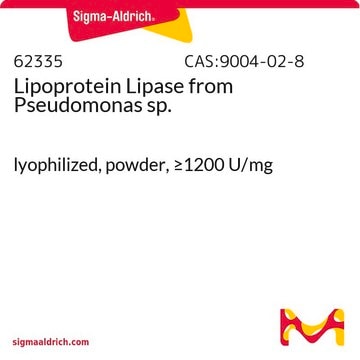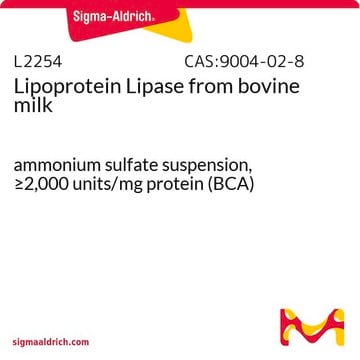62336
Lipoprotein Lipase from Pseudomonas sp.
lyophilized, powder, yellow-brown, ≥160 U/mg
Sign Into View Organizational & Contract Pricing
All Photos(1)
About This Item
Recommended Products
biological source
bacterial (Pseudomonas spp.)
Quality Level
form
powder
quality
lyophilized
specific activity
≥160 U/mg
color
yellow-brown
storage temp.
−20°C
Looking for similar products? Visit Product Comparison Guide
Biochem/physiol Actions
Lipoprotein lipase belongs to the family of triglyceride lipases. It hydrolyses triglycerides in triglyceride-rich ApoB-containing lipoproteins.
Unit Definition
1 U corresponds to the amount of enzyme which liberates 1 μmol of oleic acid per minute at pH 8.0 and 37°C (cholesteryl oleate, Cat. No. 26850, as substrate)
Storage Class Code
11 - Combustible Solids
WGK
WGK 3
Flash Point(F)
Not applicable
Flash Point(C)
Not applicable
Personal Protective Equipment
dust mask type N95 (US), Eyeshields, Gloves
Certificates of Analysis (COA)
Search for Certificates of Analysis (COA) by entering the products Lot/Batch Number. Lot and Batch Numbers can be found on a product’s label following the words ‘Lot’ or ‘Batch’.
Already Own This Product?
Find documentation for the products that you have recently purchased in the Document Library.
Joni Agustian et al.
Chirality, 24(5), 356-367 (2012-04-21)
Because chiral liquid chromatography (LC) could become a powerful tool to estimate racemic atenolol quantity, excellent enantiomeric separation should be produced during data acquisition for satisfactory observation of atenolol concentrations throughout the racemic resolution processes. Selection of chiral LC column
Karine Gontier et al.
Comparative biochemistry and physiology. Part A, Molecular & integrative physiology, 164(3), 499-505 (2013-01-03)
In waterfowl, the response to overfeeding differs from one genotype to the other. Pekin ducks generally store lipids in the peripheral tissues while Muscovy and mule ducks promote hepatic lipid storage. A possible reason for these various susceptibilities to hepatic
Q Renli et al.
Animal : an international journal of animal bioscience, 6(8), 1246-1252 (2012-12-12)
Experiments were conducted to determine the effects of Newcastle disease on chicken fat metabolism. Thirty black-bone chickens were infected intraocularly with the Newcastle disease virus (NDV). Six birds were killed at 0, 12, 24, 48 and 72 h post infection
Jonghan Kim et al.
FASEB journal : official publication of the Federation of American Societies for Experimental Biology, 27(4), 1657-1663 (2012-12-18)
Iron loading is associated with altered lipid metabolism, but underlying mechanisms remain unknown. We compared serum iron and triglycerides (TGs) in Belgrade rats, a genetic model of iron-loading anemia. Homozygous b/b rats had greater serum iron (68 vs. 28 μM;
Autocrine endocannabinoid signaling through CB1 receptors potentiates OX1 orexin receptor signaling.
Maria H Jäntti et al.
Molecular pharmacology, 83(3), 621-632 (2012-12-13)
It has been proposed that OX(1) orexin receptors and CB(1) cannabinoid receptors can form heteromeric complexes, which affect the trafficking of OX(1) receptors and potentiate OX(1) receptor signaling to extracellular signal-regulated kinase (ERK). We have recently shown that OX(1) receptor
Our team of scientists has experience in all areas of research including Life Science, Material Science, Chemical Synthesis, Chromatography, Analytical and many others.
Contact Technical Service








